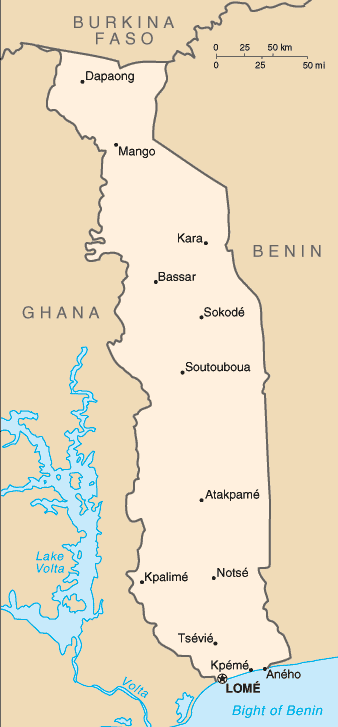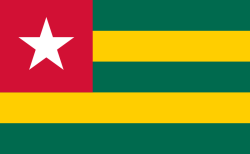Togolese Republic
Related Categories:
 Togo - Fotw
Togo - FotwA Short History of Togo. Explanation of the flag.
www.fotw.us/flags/tg.html Togo - wikipedia.org
Western history does not record what happened in Togo before the Portuguese arrived in the late fifteenth century. During the period from the eleventh century to the sixteenth century, various tribes entered the region from all directions: the Ewé from Nigeria and Benin; and the Mina and Guin from Ghana.
en.wikipedia.org/
Togo's population of 4.97 million people (2003 est.) is composed of about 21 ethnic groups. The two major groups are the Ewe in the South and the Kabye in the North. Population distribution is very uneven due to soil and terrain variations. The population is generally concentrated in the south and along the major north-south highway connecting the coast to the Sahel. Age distribution also is uneven; nearly one-half of the Togolese are less than 15 years of age. The ethnic groups of the coastal region, particularly the Ewes (about 21% of the population), constitute the bulk of the civil servants, professionals, and merchants, due in part to the former colonial administrations which provided greater infrastructure development in the south. The Kabye (12% of the population) live on marginal land and traditionally have emigrated south from their home area in the Kara region to seek employment. Their historical means of social advancement has been through the military and law enforcement forces, and they continue to dominate these services.
Most of the southern peoples use the Ewe or Mina languages, which are closely related and spoken in commercial sectors throughout Togo. French, the official language, is used in administration and documentation. The public primary schools combine French with Ewe or Kabye as languages of instruction, depending on the region. English is spoken in neighboring Ghana and is taught in Togolese secondary schools. As a result, many Togolese, especially in the south and along the Ghana border, speak some English.
www.state.gov/r/
Introduction
About
Contact
Symbols in The News
Interpret this Symbol
AAC
African
AI
Alchemy
Alphabets
Ancient
Animal Symbolism
Architecture
Art
Articles
Astrology
Baha'i
Blissymbolics
Blueprint Symbols
Buddhist
Celtic Symbols
Cemetery
Chinese Symbols
Christian
Circle
City
Codes
Color
Conlangs
Crop Circles
Danger
Da Vinci Code
Designing Logos
Dictionaries
Dreams
Education
Egyptian Symbols
Electrical
Emoticons
Find Images
Fonts
Food
Fraternity
Hamsa
Healing
Heraldry
Hermetic
Highway Signs
Hindu
History
Hobo
Holiday
Icons
iConji
Islamic
Jain Symbols
Japanese, Kanji
Jewish
Justice
Law
Literary Symbolism
Mandalas
Map
Masonic
Math, Number
Meaning of Names
Medical
Middle East
Military
Miscellaneous
Money
Music
Mythology
Native American
Playing Cards
Power
Psychology
QiQiiKhu
Reiki
Religious
Runes, Norse
Sacred Geometry
Scientific
Science Fiction
Sorority
Sports
Symbols in the News
Tattoos
ThirteenSymbols
Tree of Life
Ursprache
Videos
Visual Languages
Weather
Web Codes
Wicca
Words
Writing Systems
Braille
Coinherence
Coptic
Cuneiform
Easter Island
Etruscan
Happy Human
Hebrew
Kokopelli
Linear B
Lotus
Love Symbols
Mandorla
Moon Alphabet
Nine Pointed Star
Om
Oz
Phonetic
Scarab Beetle
Silent
Theosophy
Unifon
About
Contact
Symbols in The News
Interpret this Symbol
AAC
African
AI
Alchemy
Alphabets
Ancient
Animal Symbolism
Architecture
Art
Articles
Astrology
Baha'i
Blissymbolics
Blueprint Symbols
Buddhist
Celtic Symbols
Cemetery
Chinese Symbols
Christian
Circle
City
Codes
Color
Conlangs
Crop Circles
Danger
Da Vinci Code
Designing Logos
Dictionaries
Dreams
Education
Egyptian Symbols
Electrical
Emoticons
Find Images
Fonts
Food
Fraternity
Hamsa
Healing
Heraldry
Hermetic
Highway Signs
Hindu
History
Hobo
Holiday
Icons
iConji
Islamic
Jain Symbols
Japanese, Kanji
Jewish
Justice
Law
Literary Symbolism
Mandalas
Map
Masonic
Math, Number
Meaning of Names
Medical
Middle East
Military
Miscellaneous
Money
Music
Mythology
Native American
Playing Cards
Power
Psychology
QiQiiKhu
Reiki
Religious
Runes, Norse
Sacred Geometry
Scientific
Science Fiction
Sorority
Sports
Symbols in the News
Tattoos
ThirteenSymbols
Tree of Life
Ursprache
Videos
Visual Languages
Weather
Web Codes
Wicca
Words
Writing Systems
Braille
Coinherence
Coptic
Cuneiform
Easter Island
Etruscan
Happy Human
Hebrew
Kokopelli
Linear B
Lotus
Love Symbols
Mandorla
Moon Alphabet
Nine Pointed Star
Om
Oz
Phonetic
Scarab Beetle
Silent
Theosophy
Unifon

